A Sanctuary of Avataṃsaka: The Theoretical and Practical Studies on Huayan Buddhism Embodied in the Sculptures of the Huayan Grotto in Anyue
Abstract
1. Introcuction
2. The Statue of Li Tongxuan 李通玄 (635–730) and the Sculptures Embodying His Huayan Thought
2.1. The Statue of Li Tongxuan
2.2. The Sculptures of “Ten Assemblies in Ten Locations” 十處十會 and “Sudhana’s Pilgrimages” 善財徧參
2.3. The Statues of the Three Saints of the Huayan School
2.4. “Mind-Only” Verse 惟心偈
3. The Statue of Zongmi 宗密 (780–841) and the Sculptures Embodying His Huayan Thought
4. The Practical Studies on Huayan Buddhism
4.1. On the Huayan Spiritual Practice and Cultivation
4.2. On the Spiritual Practice and Cultivation of Perfect Enlightenment
5. Conclusions
Funding
Institutional Review Board Statement
Informed Consent Statement
Data Availability Statement
Conflicts of Interest
| 1 | Su Dogpo-style is a kind of hat style in Song Dynasty, named after Su Shi (also called Dongpo Jushi) who used to wear. The kind of hat is square in shape with obvious edges. It consists of four walls, and there are walls outside. The heights of the outer walls account for two-thirds of the inner walls. The literati of the Song Dynasty were very fond of wearing this hat. |
| 2 | Liu-Zhao sect is a locally influential Buddhist sect active in the Eastern Sichuan during the late Southern Song Dynasty (1200–1240). The sect was founded by the monk Zhao Zhifeng, who promoted the Buddhist practitioner Liu Juzhi as the spiritual leader. This sect absorbed and integrated the ideas of prominent Buddhist schools, and its main goal is to promote the followers to become Buddha through a series of practices. This sect mainly propagates teachings and attracts believers through statues, thus leaving a large number of grotto remains in Anyue and Dazu. |
| 3 | The first Chinese character is weathered, with only a few strokes remaining visible. Li Guanzhi recognizes the weathered character as “那” (G. Li 1994, p. 41), but the two characters “那略” make no sense as the title of a sutra. See Li Guanzhi. |
References
- Chen, Mingguang 陳明光, and Zhijin Deng 鄧之金. 1986. Shishu Dazu shike yu anyue shike de guanxi 試述大足石刻與安嶽石刻的關係 [The Discussion on the Relationship of Rock Carvings in Dazu and Anyue]. Sichuan Wenwu 四川文物 Sichuan Cultural Relics S1: 82. [Google Scholar]
- Chongxian 重顯, and Keqin 克勤. 1983. Foguo Yuanwu Chanshi Biyan Lu佛果圜悟禪師碧巖錄 [A Record of Chongxian’s Verses Chanted by Chan Master Keqin (Scroll 6)]. In Taishō Tripitaka 大正藏. Taipei: Xinwenfeng chuban gongsi新文豐出版公司, vol. 48, p. 193a. [Google Scholar]
- Daoyuan 道原. 1983. Jingde Chuandeng Lu景德傳燈錄 [The Jingde Record of the Transmission of the Lamp (Volume 13)]. In Taishō Tripitaka 大正藏. Taipei: Xinwenfeng chuban gongsi 新文豐出版公司, vol. 51, pp. 305c–306a. [Google Scholar]
- Gong, Jun 龔雋. 2018. Cong Huayan Jing Dao Yuanjue Jing: Tangdai Huayan Jiaoxue zhong de Jingdian Zhuanyi 從《華嚴經》到《圓覺經》: 唐代華嚴教學中的經典轉移 [From the Avatamsaka Sutra to the Sutra of Perfect Enlightenment: The Shift of the Classics of Huayan Teaching in Tang Dynasty]. Shijie Zongjiao Yanjiu 世界宗教研究 Studies in World Religions 1: 87–95. [Google Scholar]
- Hu, Jianming 胡建明. 2013. Zongmi Sixiang Zonghe Yanjiu 宗密思想綜合研究 [A Comprehensive Study of Zongmi’s Thought]. Beijing: Zhongguo renmin daxue chubanshe 中國人民大學出版社, pp. 29–33. [Google Scholar]
- Hu, Wenhe 胡文和. 1994. Sichuan Daojiao Fojiao Shiku Yishu 四川道教佛教石窟藝術 [The Art of Taoism and Buddhism Grottoes in Sichuan]. Chengdu: Sichuan renmin chubanshe 四川人民出版社, pp. 76, 317–18. [Google Scholar]
- Hu, Wenhe 胡文和. 1997. Sichuan Shiku Huayan Jing xitong Bianxiang de Yanjiu 四川石窟華嚴經系統變相的研究 [A Study of the Illustrations of the Avatamsaka Sutra in Sichuan Grottoes]. Dunhuang Yanjiu 敦煌研究 Dunhuang Research 1: 94. [Google Scholar]
- Hu, Wenhe 胡文和. 2005. Anyue Dazu Shikuzhong Chuanmi Jiaozu Liubenzunxiang Zaoxing Fenlei 安岳大足石窟中“川密”教祖柳本尊像造型分類 [Classification of ‘Chuanmi’ sect ancestor Liu Benzun statue in Dazu and Anyue Grottoes]. In Dazu ShikeYanjiu Wenji (5) 大足石刻研究文集 (5) [Proceedings of the Studies on Dazu Rock Carvings (5)]. Compiled by Chongqing dazu shike yishu bowuguan 重慶大足石刻藝術博物館 [Chongqing Dazu Stone Carving Art Museum]. Chongqing: Chongqing chubanshe 重慶出版社, p. 231. [Google Scholar]
- Hu, Wenhe 胡文和. 2009. Dazu Anyue Songdai Huayan Xitong Zaoxiang Yuanliu He Zongjiao Yiyi Xin Tansuo—Yi Dazu Baoding Pilu Daochang He Yuanjuedong Tuxiang Wei Li 大足、安岳宋代華嚴系統造像源流和宗教意義新探索—以大足寶頂毘盧道場和圓覺洞圖像為例 [New Exploration on the Origin and Religious Significance of the Statues of the Huayan System in the Song Dynasties in Dazu and Anyue—Exemplified by the Images of Baoding Pulu Dharma Realm and Yuanjue Grotto in Dazu]. Dunhuang Yanjiu 敦煌研究 Dunhuang Research 4: 47–54. [Google Scholar]
- Jujian 居簡. 1993. Yuanjue Jing Jizhu Xu 圓覺經集注序 [Preface to the Collected Commentaries on the Sutra of Perfect Enlightenment]. In Zokuzokyo 卍續藏. Taipei: Xinwenfeng chuban gongsi 新文豐出版公司, vol. 16, p. 1b. [Google Scholar]
- Kojima, Taizan 小島岱山. 2000. Zhongguo Huayan Sixiangshi de Zai Renshi---Wutaishan Xi Huayan Sixiang yu Zhongnanshan Xi Huayan Sixiang 中國華嚴思想史的再認識——五臺山系華嚴思想與終南山系華嚴思想 [Revisiting the History of Huayan Thought in China: Wutaishan Huayan Thought and Zhongnanshan Huanyan Thought]. Transated by Yu-xiong Huang 黃玉雄. Wutaishan Yanjiu 五臺山研究 Mt. Wutai Researches 4: 14. [Google Scholar]
- Lei, Yuhua 雷玉華. 2014. Sichuan Shiku Fenqu yu Fenqi Chulun 四川石窟分區與分期初論 [A Preliminary Study on the Divisions and Stages of the Grottoes in Sichuan]. In Nanfang Minzu Kaogu南方民族考古 [Southern Ethnology and Archaeology]. Beijing: Kexue chubanshe 科學出版社, vol. 10, p. 198. [Google Scholar]
- Li, Guanzhi 李官智. 1994. Anyue Huayandong Shiku 安岳華嚴洞石窟 [The Huayan Grotto in Anyue]. Sichuan Wenwu 四川文物 Sichuan Cultural Relics 3: 40–43. [Google Scholar]
- Li, Jingjie 李靜傑. 2011. Lun Songdai Shancai Tongzi Wushisan Can Tuxiang 論宋代善財童子五十三參圖像 [On the Images of Sudhana’s Fifty-Three Pilgrimages in the Song Dynasties]. In Yishu Shi Yanjiu 藝術史研究 [Art History Research]. Guangzhou: Zhongshan daxue chubanshe中山大學出版社, vol. 13, p. 295. [Google Scholar]
- Li, Tongxuan 李通玄. 1983a. Jiemi Xianzhi Chengbei Shi Ming Lun 解迷顯智成悲十明論 [Ten Manifestations of Resolving Doubts, Manifesting Wisdom and Attaining Compassion]. In Taishō Tripitaka 大正藏. Taipei: Xinwenfeng chuban gongsi新文豐出版公司, vol. 45, pp. 768b, 768c. [Google Scholar]
- Li, Tongxuan 李通玄. 1983b. Lue Shi Xin Huayan Jing Xiuxing Cidi Jueyilun 略釋新華嚴經修行次第決疑論 [A Brief Interpretation on the Casuistry of the Practice Sequence in the New Commentaries on the Avatamsaka Sutra]. In Taishō Tripitaka 大正藏. Taipei: Xinwenfeng chuban gongsi 新文豐出版公司, vol. 36, pp. 1013b, 1014a, 1046a, 1046b, 1048c. [Google Scholar]
- Li, Tongxuan 李通玄. 1983c. Xin Huayan Jing Lun 新華嚴經論 [New Commentaries on the Avatamsaka Sutra]. In Taishō Tripitaka 大正藏. Taipei: Xinwenfeng chuban gongsi新文豐出版公司, vol. 36, pp. 738a, 739a, 747b, 751a, 751c, 738a, 768b, 817a. [Google Scholar]
- Liu, Changjiu 劉長久, ed. 1998. Zhongguo Xinan Shiku Yishu 中國西南石窟藝術 [The Art of the Grottoes in Southwest China]. Chengdu: Sichuan renmin chubanshe 四川人民出版社, pp. 22, 24. [Google Scholar]
- Ma, Zhi 馬支. 1993. Shi Da Fangguang Fo Huayan Jing Lunzhu Li Zhangzhe Shiji 釋大方廣佛華嚴經論主李長者事蹟 [Biography of Patriarch Li, the Commentator of the Avatamsaka Sutra]. In Zokuzokyo 卍續藏. Taipei: Xinwenfeng chuban gongsi 新文豐出版公司, vol. 5, p. 654b. [Google Scholar]
- Mi, Defang 米德昉. 2019. 12–13 shiji Chuanyu Fojiao Zhaozhifengpai Jiqi Shiku Zaoxiang 12–13世紀川渝佛教“趙智鳳派”及其石窟造像 [Zhaozhifeng Sect of Buddhism and grottoes in Sichuan and Chongqing in the 12th–13th Centuries]. In Huayan Zhuanzong Guoji Xueshu Yantaohui Lunwenji 2017 華嚴專宗國際學術研討會論文集2017 [Proceedings of the International Conference on Huayan Buddhism 2017]. Compiled by Chen Yibiao 陳一標. Taibei: Huayanlianshe華嚴蓮社, pp. 518–19. [Google Scholar]
- Pan, Liangwen 潘亮文. 2015. Dunhuang Shiku Huayan Jingbian Zuopin de Zai Sikao—Yi Tangdai Wei Zhongxin 敦煌石窟華嚴經變作品的再思考—以唐代為中心 [Rethinking the Illustrations of the Avatamsaka Sutra in Dunhuang Grottoes—Focusing on the Tang Dynasty]. Dunhuang Yanjiu 敦煌研究 Dunhuang Research 5: 11–19. [Google Scholar]
- Pei, Xiu 裴休. 1983. Da Fangguang Yuanjue Xiuduoluo Liaoyi Jing Lue shu xu 大方廣圓覺修多羅了義經略疏序 [Preface to the Abbreviated Commentary on the Sutra of Perfect Enlightenment]. In Taishō Tripitaka 大正藏. Taipei: Xinwenfeng chuban gongsi新文豐出版公司, vol. 39, p. 523c. [Google Scholar]
- Quan, Haizhu 全海住. 2003. Dui Mogaoku Huayan JingBianxiang de Kaocha 對莫高窟華嚴經變相的考察 [An Examination of the Illustrations of the Avatamsaka Sutra in Mogao Grottoes]. In 2000 Nian Dunhuangxue Guoji Xueshu Taolunhui Wenji—Shiku Kaogu Juan 2000年敦煌學國際學術討論會文集·石窟考古卷 [Proceedings of the International Academic Symposium on Dunhuang Studies in 2000: Grotto Archeology]. Compiled by Dunhuang Yanjiuyuan 敦煌研究院 [Dunhuang Academy]. Lanzhou: Gansu minzu chubanshe 甘肅民族出版社, pp. 133–55. [Google Scholar]
- Sichuan daxue kaogu wenbo xueyuan 四川大學考古文博學院 [School of Archaeology and Museology and Center], and Anyue xian wenwu baohu zhongxin 安岳縣文物保護中心 [Anyue County Cultural Relics Protection Center]. 2021. Sichuan Sheng Anyue Xian Huayandong Shiku Saogu Baogao 四川省安岳縣華嚴洞石窟考古報告 [An Archaeological Report on the Huayan Grotto in Anyue County, Sichuan Province]. In Nanfang Minzu Kaogu 南方民族考古 [Southern Ethnology and Archaeology]. Beijing: Kexue chubanshe 科學出版社, vol. 23, pp. 43–94. [Google Scholar]
- Siksananda 實叉難陀, trans. 1993. Huayan Jing He Lun 華嚴經合論 [The Combined Commentary and the Avatamsaka Sutra (Scroll 14)]. In Zokuzokyo 卍續藏. Commented by Li Tongxuan. Taipei: Xinwenfeng chuban gongsi 新文豐出版公司, vol. 5: pp. 753b, 785b, 786a, 836a, 890b, 700b, 712b, 921b; vol. 6: pp. 34a, 107b, 124b, 184a, 190a, 251a, 262a, 429b, 432b, 729a, 861b, 882a, 892a. [Google Scholar]
- Wang, Juren 王居仁. 1982. Shenfushansi Lingji Ji 神福山寺靈跡記 [Record of Miracles at Shenfu Mountain Temple]. In Shike Shiliao Xinbian. Series 1. 石刻史料新編 (第1輯第20冊) [New Historical Materials of Stone Scultpures]. Taipei: Xinwenfeng chuban gongsi 新文豐出版公司, vol. 20, pp. 15131a, 15132a. [Google Scholar]
- Wang, Xiangzhi 王象之. 2003. Yuji Jisheng 輿地紀勝 [The Record of Scenic Spots (Scroll 161)]. Beijing: Zhonghua shuju中華書局, p. 4367. [Google Scholar]
- Wei, Daoru 魏道儒. 2017. Tangsong Foxue 唐宋佛学 [Buddhist Studies of Tang and Song Dynasty]. Beijing: Zhongguo shehui kexue chubanshe 中国社会科学出版社, pp. 57–62. [Google Scholar]
- Weibai 惟白. 1983. Foguo Chanshi Wenshu Zhinan Tuzan 佛國禪師文殊指南圖贊 [Chan Master Foguo’s Illustrated Verses of Praise on the Teaching of Manjusri]. In Taishō Shinshū Daizōkyō 大正新修大藏經. Commented by Shangying Zhang 張商英. Taipei: Xinwenfeng chuban gongsi新文豐出版公司, vol. 45, p. 793a. [Google Scholar]
- Wen, Yucheng 溫玉成. 2007. Dazu Baoding Shiku Zhenxiang Jiedu 大足寶頂石窟真相解讀 [The Truth about Dazu Baoding Grottoes]. In 2005nian Chongqing Dazu Shike Guoji Xueshu Yantaohui Lunwenji 2005 年重慶大足石刻國際學術研討會論文集 [Proceedings of the International Symposium on Chongqing Dazu Rock Carvings]. Compiled by Chongqing dazu shike yishu bowuguan 重慶大足石刻藝術博物館 [Chongqing Dazu Stone Carving Art Museum]. Beijing: Wenwu chubanshe 文物出版社, p. 118. [Google Scholar]
- Yang, Jialuo 楊家駱. 1985. Dazu Longgangqu Shike Jilue 大足寶頂區石刻記略 [The Record of Stone Carvings in Baoding District, Dazu]. In Dazu Shike Yanjiu 大足石刻研究 [Collected Works of the Researches on Dazu Stone Carving]. Compiled by Liu Changjiu, Hu Wenhe and Li Yongqiao. Chengdu: Sichuansheng shehui kexue chubanshe四川省社會科學出版社, pp. 25–27. [Google Scholar]
- Yuan, Anzhi 貟安志. 1986. “Anyue Shikusi Diaocha Jiyao” 安岳石窟寺調查紀要 [A Summary of the Investigation on the Grotto Temples in Anyue]. Kaogu Yu Wenwu 考古與文物 Archaeology and Cultural Relics 6: 45–52. [Google Scholar]
- Zan, Ning 贊寧. 1987. Song Gaoseng Zhuan 宋高僧傳 [Biography of Eminent Monks of the Song Dynasties]. Compiled by Xiangyong Fan 範祥雍. Beijing: Zhonghua shuju 中華書局, vol. 22, pp. 574–75. [Google Scholar]
- Zeng, Deren 曾德仁. 2001. Sichuan Anyue Shiku de Niandai yu Fenqi 四川安岳石窟的年代與分期 [The Chronological Dating and Stages of the Grottoes in Anyue, Sichuan]. Sichuan Wenwu 四川文物 Sichuan Cultural Relics 2: 57–58. [Google Scholar]
- Zhining 志寧. 1993. Da Fangguang Fo Huayan Jing He Lun Xu 大方廣佛華嚴經合論序 [Preface to The Combined Commentary on the Avatamsaka Sutra]. In Zokuzokyo 卍續藏. Taipei: Xinwenfeng chuban gongsi 新文豐出版公司, vol. 5, p. 653a. [Google Scholar]
- Zhipan 志磐. 2012. Fozu Tongji Jiaozhu 佛祖統紀校注 [Annotated Records of the Buddhist Patriarchs]. Annotated by Monk Daofa釋道法. Shanghai: Shanghai guji chubanshe 上海古籍出版社, vol. 29, p. 657. [Google Scholar]
- Zhu, Fonian 竺佛念, trans. 1983. Pusa Yingluo Benye Jing 菩薩瓔珞本業經 [Sutra of the Garland of a Bodhisattva’s Primary Karmas (Scroll 1)]. In Taishō Tripitaka 大正藏. Taipei: Xinwenfeng chuban gongsi 新文豐出版公司, p. 1010c. [Google Scholar]
- Zongmi 宗密. 1983a. Da Fangguang Yuanjue Xiuduoluo Liaoyi Jing Lueshu 大方廣圓覺修多羅了義經略疏 [Abbreviated Commentary on the Sutra of Perfect Enlightenment]. In Taishō Tripitaka 大正藏. Taipei: Xinwenfeng chuban gongsi新文豐出版公司, vol. 39, Scroll 1, p. 537a; Scroll 1b, p. 539a; Scroll 2b, p. 571a. [Google Scholar]
- Zongmi 宗密. 1983b. Yuanjue Jing Lueshu Chao 圓覺經略疏鈔 [Annotated Abbreviated Commentary on the Sutra of Perfect Enlightenment (Scroll 2)]. In Taishō Tripitaka 大正藏. Taipei: Xinwenfeng chuban gongsi 新文豐出版公司, vol. 15, pp. 212b, 213a, 218b. [Google Scholar]
- Zongmi 宗密. 1993. Yuanjue Jing Daochang Xiuzheng Yi 圓覺經道場修證儀 [Rituals for Cultivating and Verifying the Sutra of Perfect Enlightenment in Bodhimandalas (scroll 1)]. In Zokuzokyo 卍續藏. Taipei: Xinwenfeng chuban gongsi 新文豐出版公司, vol. 128, pp. 723a, 728b, 729a. [Google Scholar]
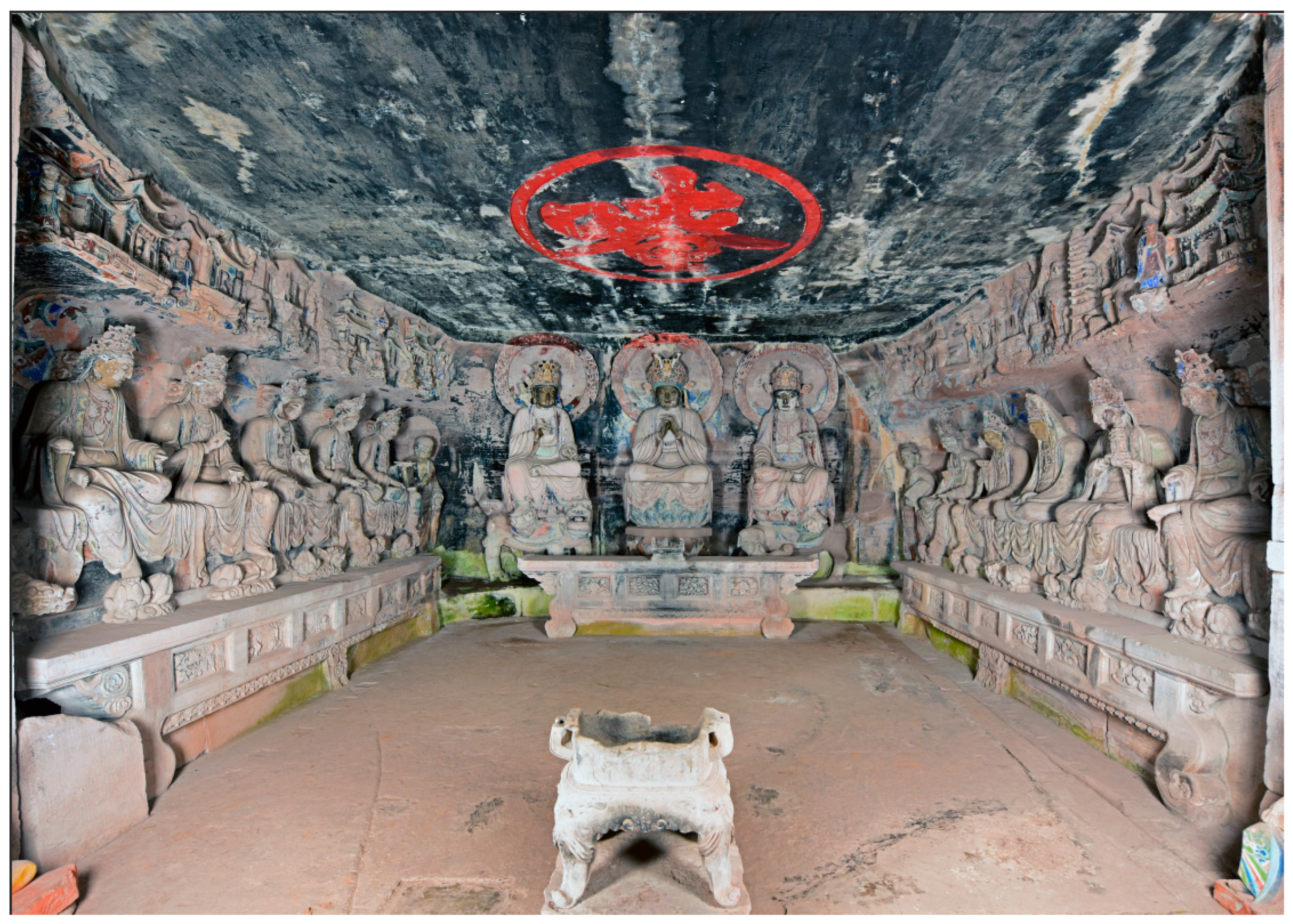
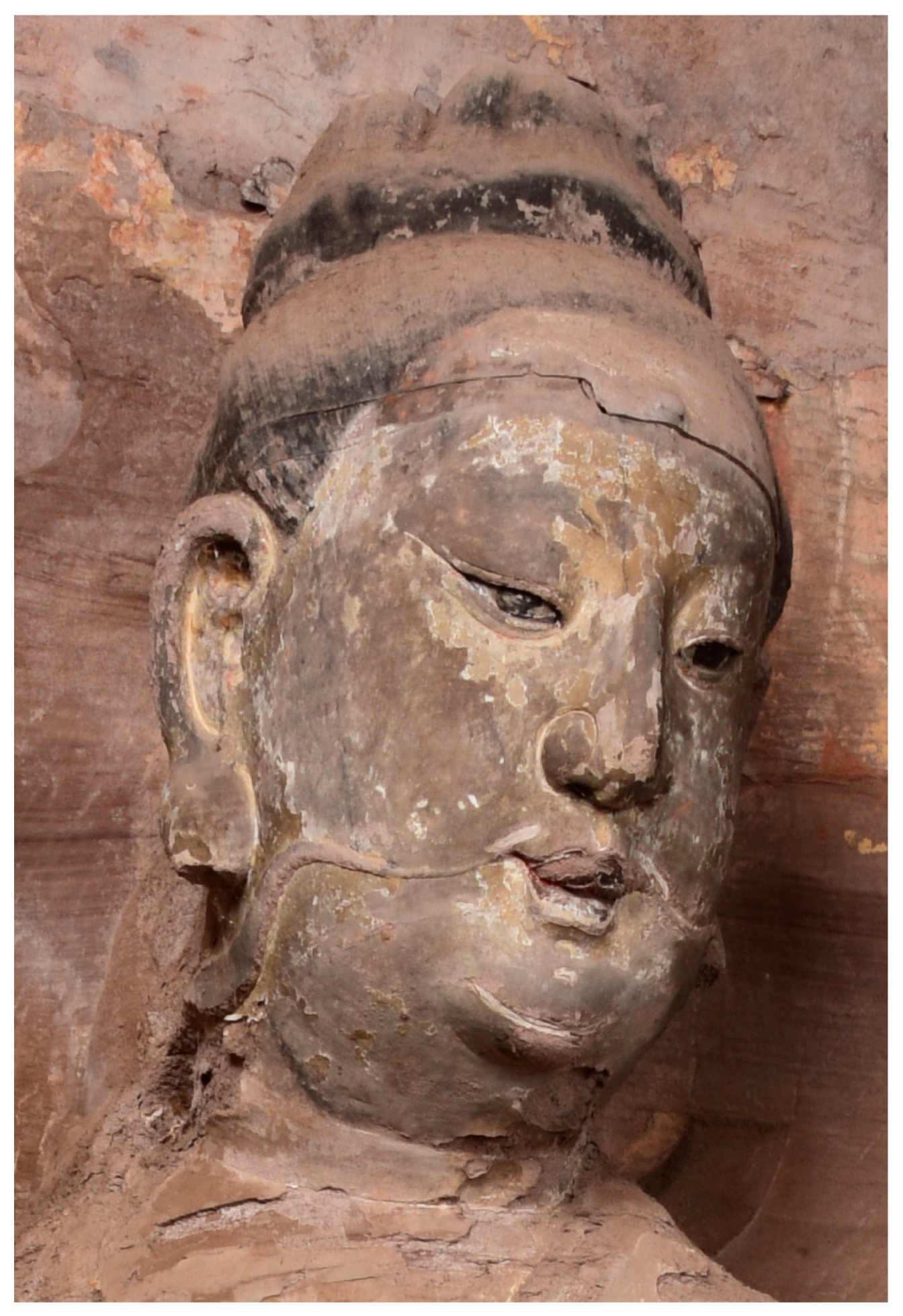




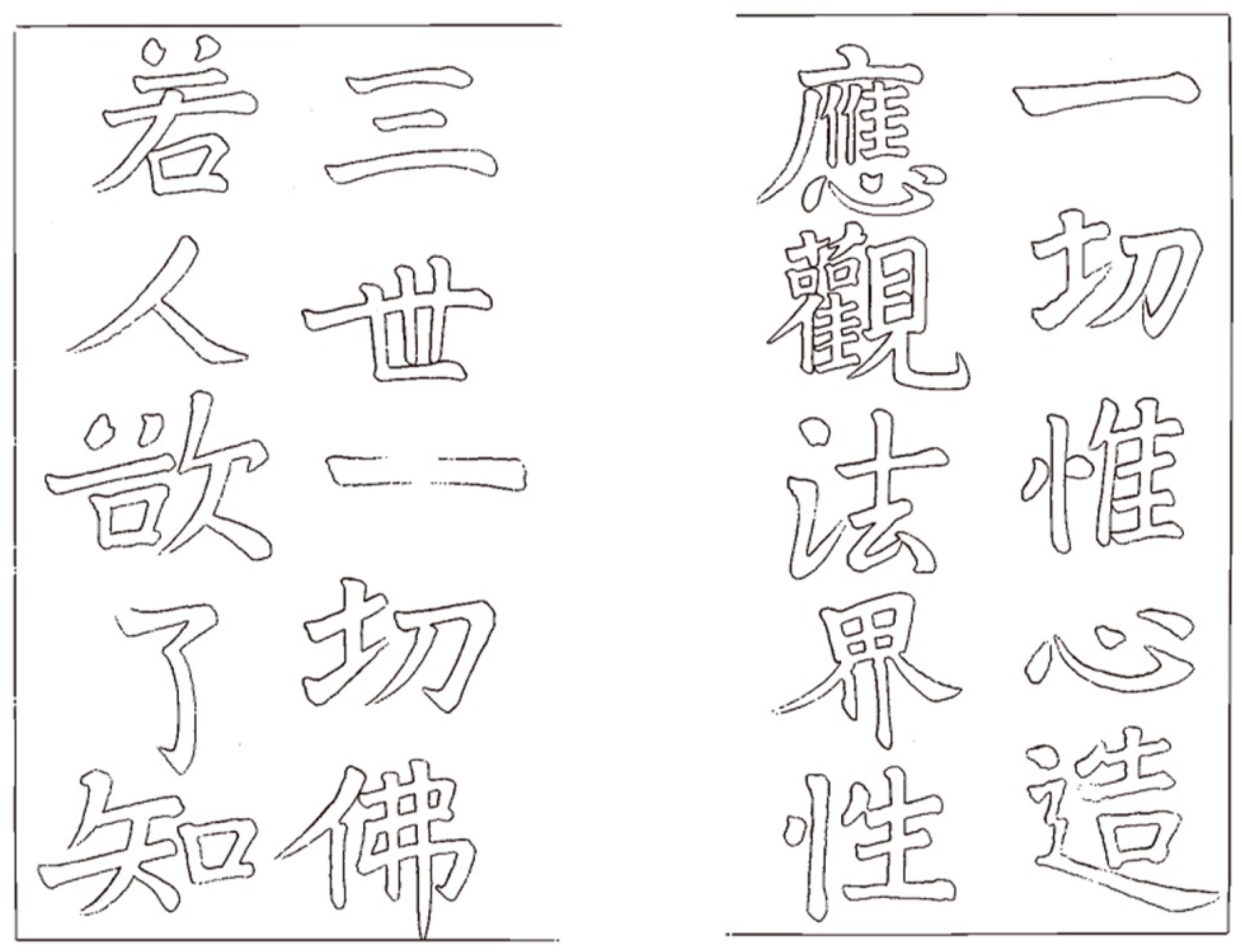
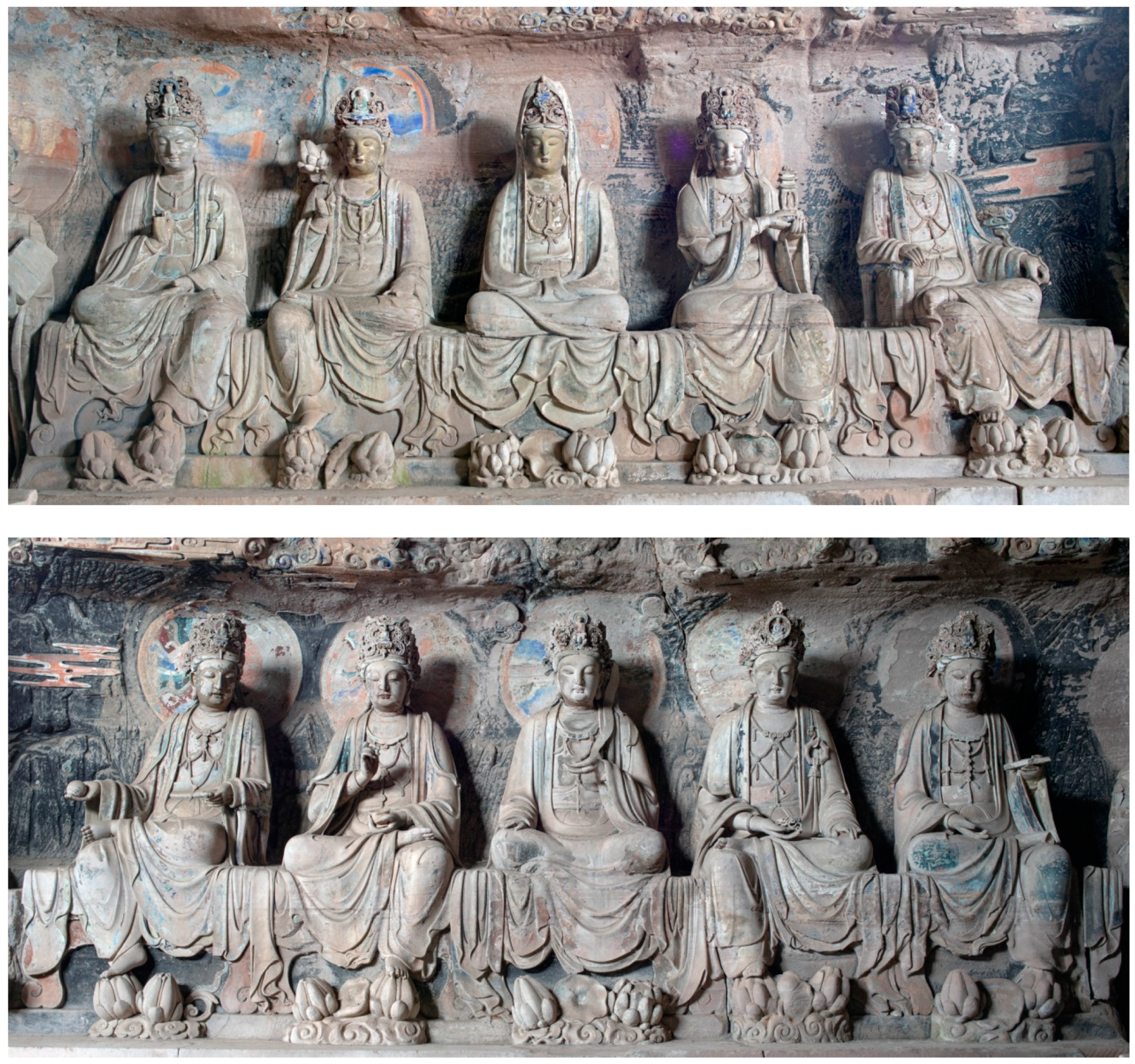
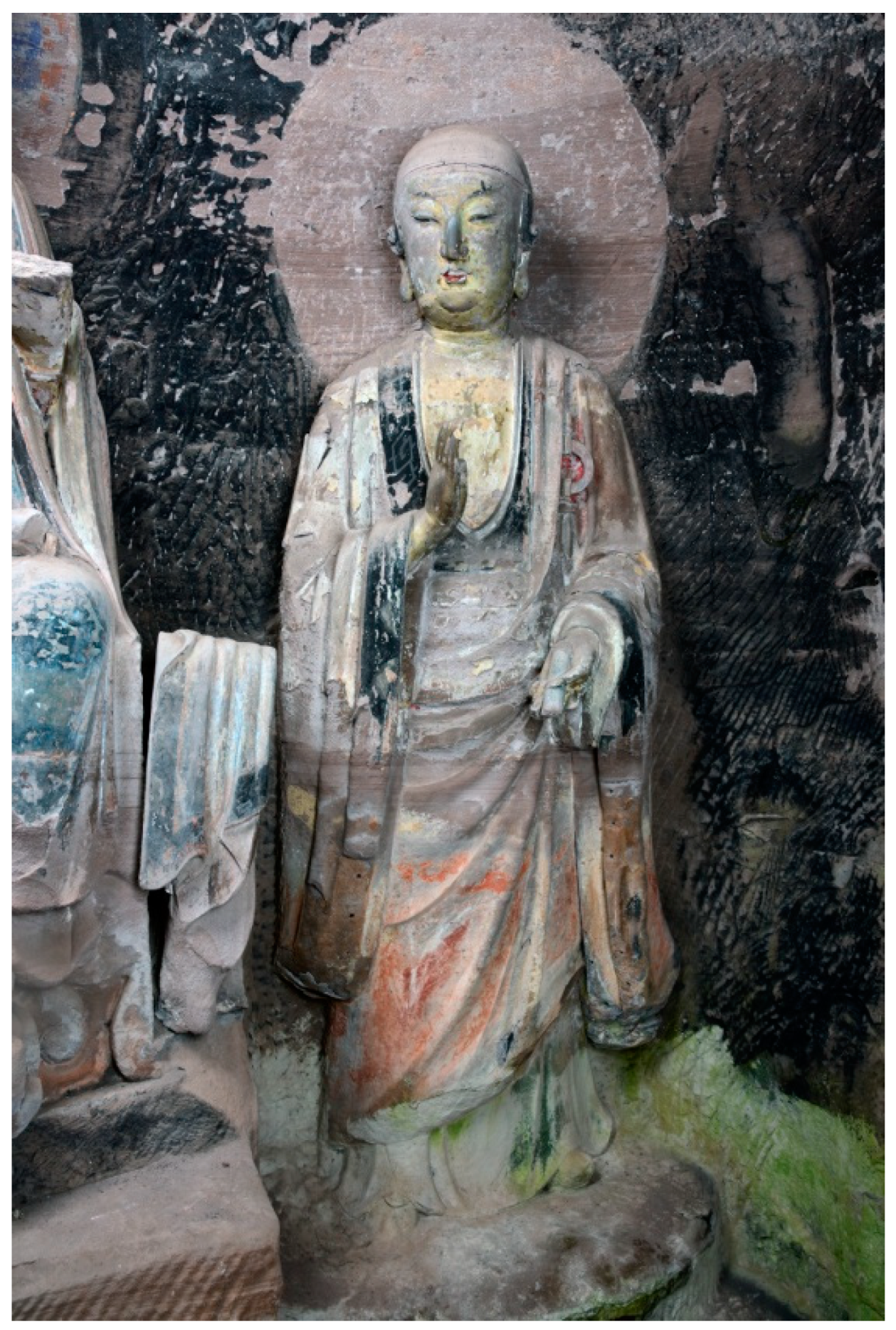
Disclaimer/Publisher’s Note: The statements, opinions and data contained in all publications are solely those of the individual author(s) and contributor(s) and not of MDPI and/or the editor(s). MDPI and/or the editor(s) disclaim responsibility for any injury to people or property resulting from any ideas, methods, instructions or products referred to in the content. |
© 2025 by the author. Licensee MDPI, Basel, Switzerland. This article is an open access article distributed under the terms and conditions of the Creative Commons Attribution (CC BY) license (https://creativecommons.org/licenses/by/4.0/).
Share and Cite
Zhang, Y. A Sanctuary of Avataṃsaka: The Theoretical and Practical Studies on Huayan Buddhism Embodied in the Sculptures of the Huayan Grotto in Anyue. Religions 2025, 16, 438. https://doi.org/10.3390/rel16040438
Zhang Y. A Sanctuary of Avataṃsaka: The Theoretical and Practical Studies on Huayan Buddhism Embodied in the Sculptures of the Huayan Grotto in Anyue. Religions. 2025; 16(4):438. https://doi.org/10.3390/rel16040438
Chicago/Turabian StyleZhang, Yuanyuan. 2025. "A Sanctuary of Avataṃsaka: The Theoretical and Practical Studies on Huayan Buddhism Embodied in the Sculptures of the Huayan Grotto in Anyue" Religions 16, no. 4: 438. https://doi.org/10.3390/rel16040438
APA StyleZhang, Y. (2025). A Sanctuary of Avataṃsaka: The Theoretical and Practical Studies on Huayan Buddhism Embodied in the Sculptures of the Huayan Grotto in Anyue. Religions, 16(4), 438. https://doi.org/10.3390/rel16040438




